EMEA Marketer’s Content Toolbox: How to Drive Growth Through Content (Part 2)
This is the second part of a blog series on how marketers can better build and optimize content for EMEA. You can read Part 1 here.
 The truth is – people research B2B tech products and there are types of content that align best to each stage of their journey. The journey isn’t always linear, but what IT pros need to know throughout the process and their digital research preferences are very important in building a content plan. In this Part 2, we explore research behind content and journey alignment and how to meet the researcher’s digital preferences as they navigate the buy.
The truth is – people research B2B tech products and there are types of content that align best to each stage of their journey. The journey isn’t always linear, but what IT pros need to know throughout the process and their digital research preferences are very important in building a content plan. In this Part 2, we explore research behind content and journey alignment and how to meet the researcher’s digital preferences as they navigate the buy.
Digital research preferences
Content can be powerful but it needs to be created for the right audience, on the topics of most interest, and distributed in the right places to truly be successful.
Your content lives across an expanded universe, not just within your own channels. You have an ecosystem of partner channels, paid media channels, organic search channels, etc. So you need to understand the buyer behaviors across these channels because that drives a lot of the decisions you, as a vendor, need to make around content.
Buyer research is becoming self-sufficient
Key findings from TechTarget’s 2021 Media Consumption Survey show that the journey for B2B tech purchases has evolved over the past few years to be very self-sufficient and digitally driven, but that has been accelerated by the pandemic.
83% of the research process is now done completely independently, without the need to interact with a vendor. And 62% can develop their purchase criteria and their vendor shortlist based solely on digital content that they find online.
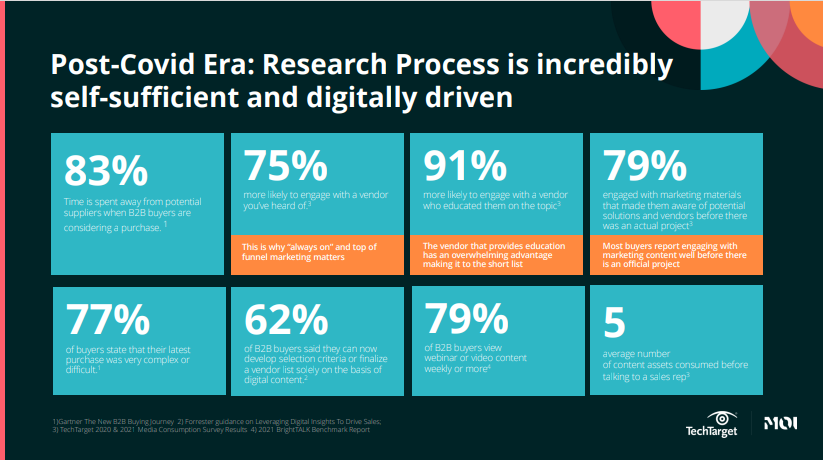
This means that your own channels, like your website and your microsites, as well as those of your media partners, will do a lot of the heavy lifting to create that positive user and customer experience with your messaging and your brand.
Where IT buyers research
But where do your buyers go to find content that will help them with their technology purchases?
The good news is that vendor websites are the top destination for content right across the buying cycle, from early to late stage. This means you have control over a large part of the customer experience. So make sure your website is designed with the customer in mind with a clear flow and a way for your prospects to consume the most valuable information easily.
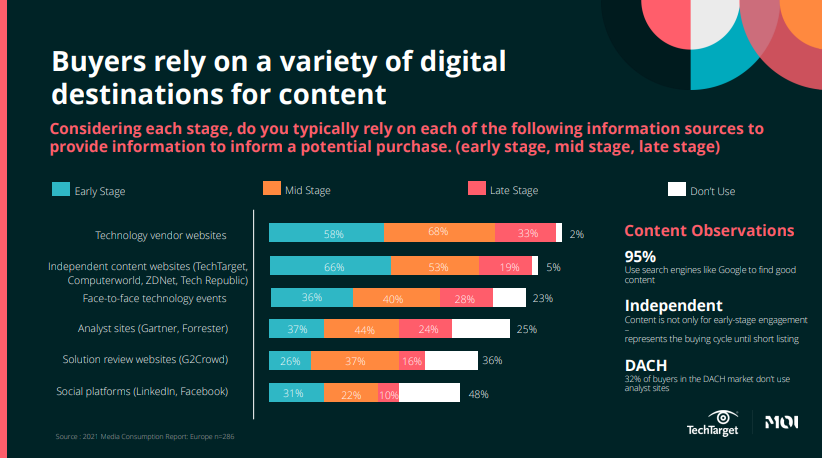
The second-most used resource for researching vendors is independent publishers like Computerworld, ZDNet, and TechTarget. 98% of European buyers say they prioritize independent destinations, particularly in the early and mid-stages of research. This reliance is an increase on what we’ve seen over the past couple of years. But it makes sense for early-stage research as the publishers offer non-biased, vendor-agnostic, educational content that helps buyers navigate their research needs.
Unsurprisingly, Google is still playing a huge part in how buyers are finding content. This means you need to make sure that your SEO is on point as a vendor so you’re easily searchable on Google. But you also want to work with media partners that have a robust Google presence because they will naturally bring in the right prospects for you to market to.
What content is most useful at each buying stage?
Now you know where buyers are searching and which destinations they prefer at each stage of the buying cycle, you want to know which types of content resonate best at each stage.
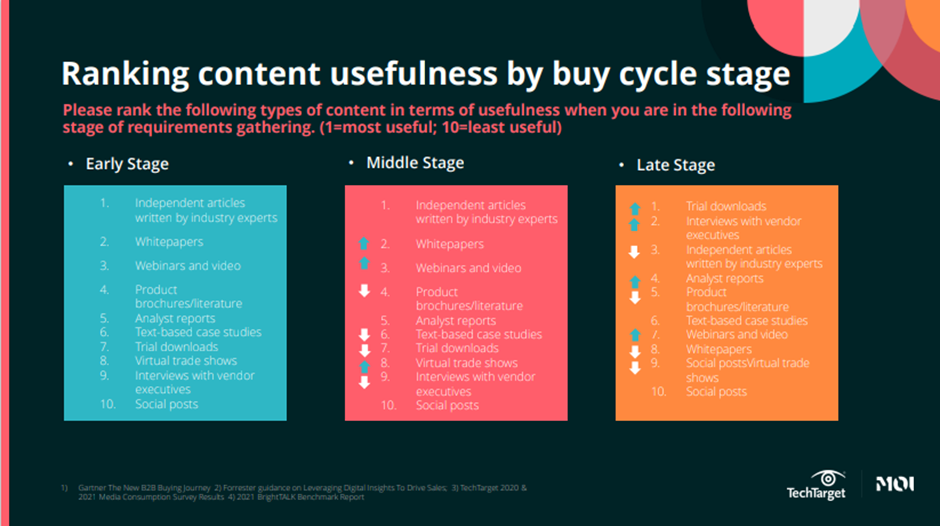
There is only one type of content that is high on the list for value at every stage of the buyer journey – independent articles written by industry experts.
Independent articles can address a multitude of pain points around the technology area, including reviewing and comparing vendors and products through the lens of a third-party expert that won’t be biased.
White papers, webinars, and videos all rank highly in the early and mid-stage of research as preferred content types. In the late stages, trial downloads, interviews with vendor executives, and analyst reports rise in the ranks.
Interviews with vendor executives can be a powerful tool for closing a sale as the senior decision maker gets the final say in the purchase. Once the shortlist has been drawn up by others in the team, the senior decision maker will need to be convinced of how the vendor will solve their business pain. Could you include interviews in your content marketing?
What content should you be creating?
71% of IT buyers still lean toward reading text-based and PDF content, so you still want to have white papers, eBooks, analyst reports, etc. in your content marketing strategy.
Notably, translation of content – text-based and video – into local languages is also important, not because buyers need to read the content in their own language, but because it signals that the vendor has a strong local presence in their country and can offer local support. This is particularly important to France, the DACH region, and Spain.
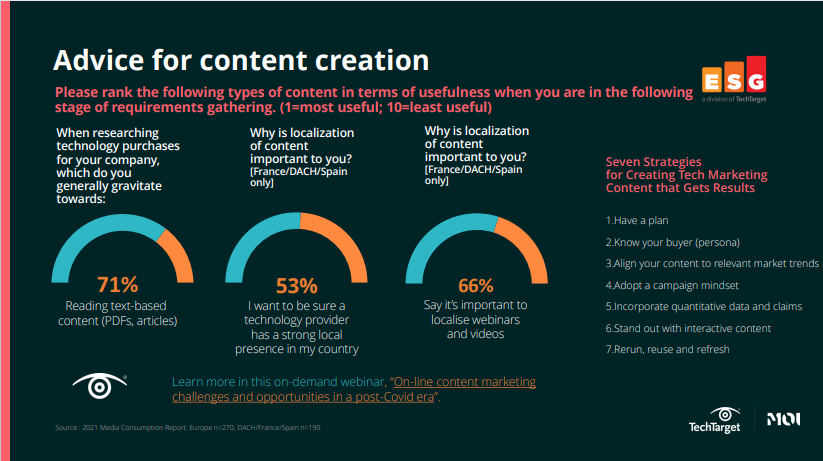
Webinars and (the fallacy of) digital fatigue
Webinars and digital events have been popular B2B content formats. But there have been many vendors questioning whether they should continue to put them on as there has been so much talk of digital fatigue.
However, only 30% of European buyers say they are getting tired of attending online webinars and virtual events. In fact, BrightTalk saw a 29% increase in live attendance in the last 12 months and over 80% of IT professionals attend at least one virtual event per month in 2020. So, multimedia content is an effective content type to layer into your content marketing and strategy.
Just make sure your multimedia content focuses on topics that will resonate with your market. Intent data can be very useful for identifying these market trends and what topics are driving engagement from your buyers.
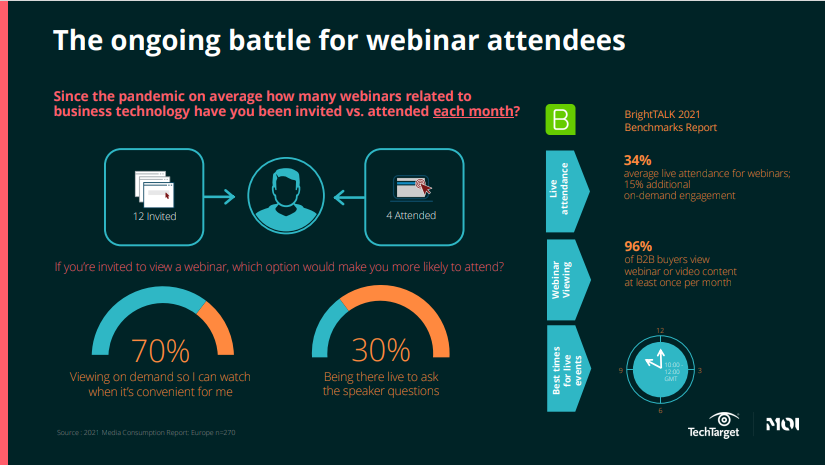
How to optimize your marketing and data
To conclude, here are some action points you may want to consider:
First, evaluate your current user experience. Be objective and empirical about it.
What are the touch points, how many are there, and where are they in your buyer journey today? Where are the gaps and where do people drop off? And how does your organization talk about content and its return on investment?
Your organization needs to have the right measurement framework in place for tracking content ROI so they know that this is an investment that is going to yield revenue results down the pipe.
Secondly, your user experience won’t be helpful unless you’re providing this experience to the right audience. So evaluate the digital channels that you are aligning and partnering with.
Are you using the right media partners that attract the right audience for you to tap into and influence? Do you have access to the intent data that helps identify the market trends and what your audience cares about? Knowing this will guide and inform the content that you create and help you provide a better user experience for your prospects and drive better results for your organization.
If you want to discuss marketing challenges and strategies, you can reach out to MOI Global.
If you want to find out more about intent data and how intent platforms can optimize your audience and marketing alignment, get in touch with TechTarget.
This blog provides unique perspectives and expertise based on our direct experiences within the EMEA market and is designed to be a resource for marketers targeting or working directly within this market.
B2B content creation, b2b technology buyers, content marketing, EMEA Content Marketing



